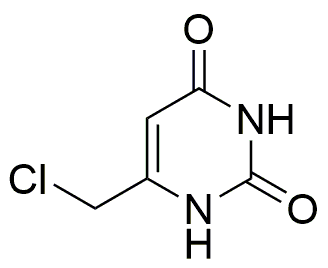6-Chloromethyluracil is widely utilized in research focused on:
- Pharmaceutical Development: This compound serves as a key intermediate in the synthesis of various antiviral and anticancer agents, enhancing drug efficacy and targeting specific diseases.
- Biochemical Research: It is used in studies exploring nucleic acid interactions, helping researchers understand DNA and RNA processes, which is crucial for genetic engineering and biotechnology.
- Polymer Chemistry: 6-Chloromethyluracil can be incorporated into polymer matrices, leading to the development of novel materials with unique properties for applications in drug delivery systems.
- Diagnostic Tools: This chemical is utilized in the creation of specific probes and markers for detecting nucleic acids, aiding in medical diagnostics and research applications.
- Agricultural Chemistry: It finds applications in developing herbicides and pesticides, contributing to crop protection and improved agricultural yields.
General Information
Properties
Safety and Regulations
Applications
6-Chloromethyluracil is widely utilized in research focused on:
- Pharmaceutical Development: This compound serves as a key intermediate in the synthesis of various antiviral and anticancer agents, enhancing drug efficacy and targeting specific diseases.
- Biochemical Research: It is used in studies exploring nucleic acid interactions, helping researchers understand DNA and RNA processes, which is crucial for genetic engineering and biotechnology.
- Polymer Chemistry: 6-Chloromethyluracil can be incorporated into polymer matrices, leading to the development of novel materials with unique properties for applications in drug delivery systems.
- Diagnostic Tools: This chemical is utilized in the creation of specific probes and markers for detecting nucleic acids, aiding in medical diagnostics and research applications.
- Agricultural Chemistry: It finds applications in developing herbicides and pesticides, contributing to crop protection and improved agricultural yields.
Documents
Safety Data Sheets (SDS)
The SDS provides comprehensive safety information on handling, storage, and disposal of the product.
Product Specification (PS)
The PS provides a comprehensive breakdown of the product’s properties, including chemical composition, physical state, purity, and storage requirements. It also details acceptable quality ranges and the product's intended applications.
Certificates of Analysis (COA)
Search for Certificates of Analysis (COA) by entering the products Lot Number. Lot and Batch Numbers can be found on a product’s label following the words ‘Lot’ or ‘Batch’.
*Catalog Number
*Lot Number
Certificates Of Origin (COO)
This COO confirms the country where the product was manufactured, and also details the materials and components used in it and whether it is derived from natural, synthetic, or other specific sources. This certificate may be required for customs, trade, and regulatory compliance.
*Catalog Number
*Lot Number
Safety Data Sheets (SDS)
The SDS provides comprehensive safety information on handling, storage, and disposal of the product.
DownloadProduct Specification (PS)
The PS provides a comprehensive breakdown of the product’s properties, including chemical composition, physical state, purity, and storage requirements. It also details acceptable quality ranges and the product's intended applications.
DownloadCertificates of Analysis (COA)
Search for Certificates of Analysis (COA) by entering the products Lot Number. Lot and Batch Numbers can be found on a product’s label following the words ‘Lot’ or ‘Batch’.
*Catalog Number
*Lot Number
Certificates Of Origin (COO)
This COO confirms the country where the product was manufactured, and also details the materials and components used in it and whether it is derived from natural, synthetic, or other specific sources. This certificate may be required for customs, trade, and regulatory compliance.


